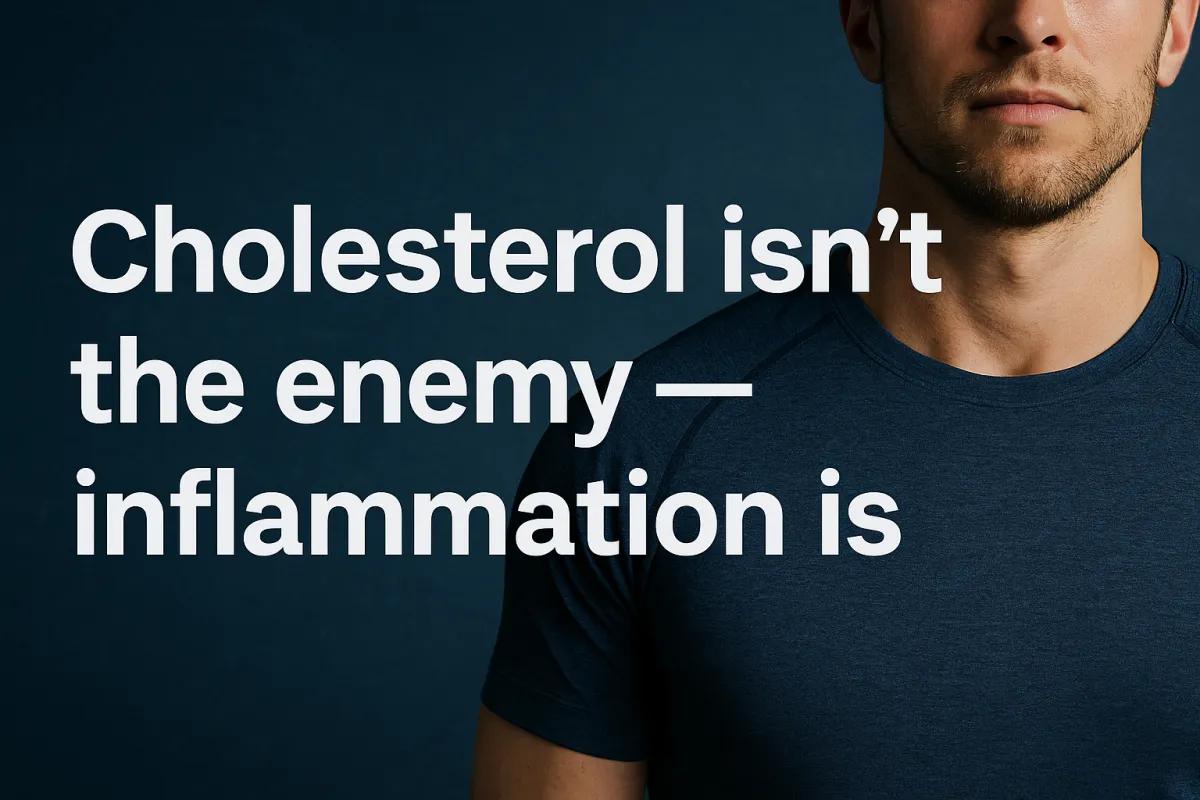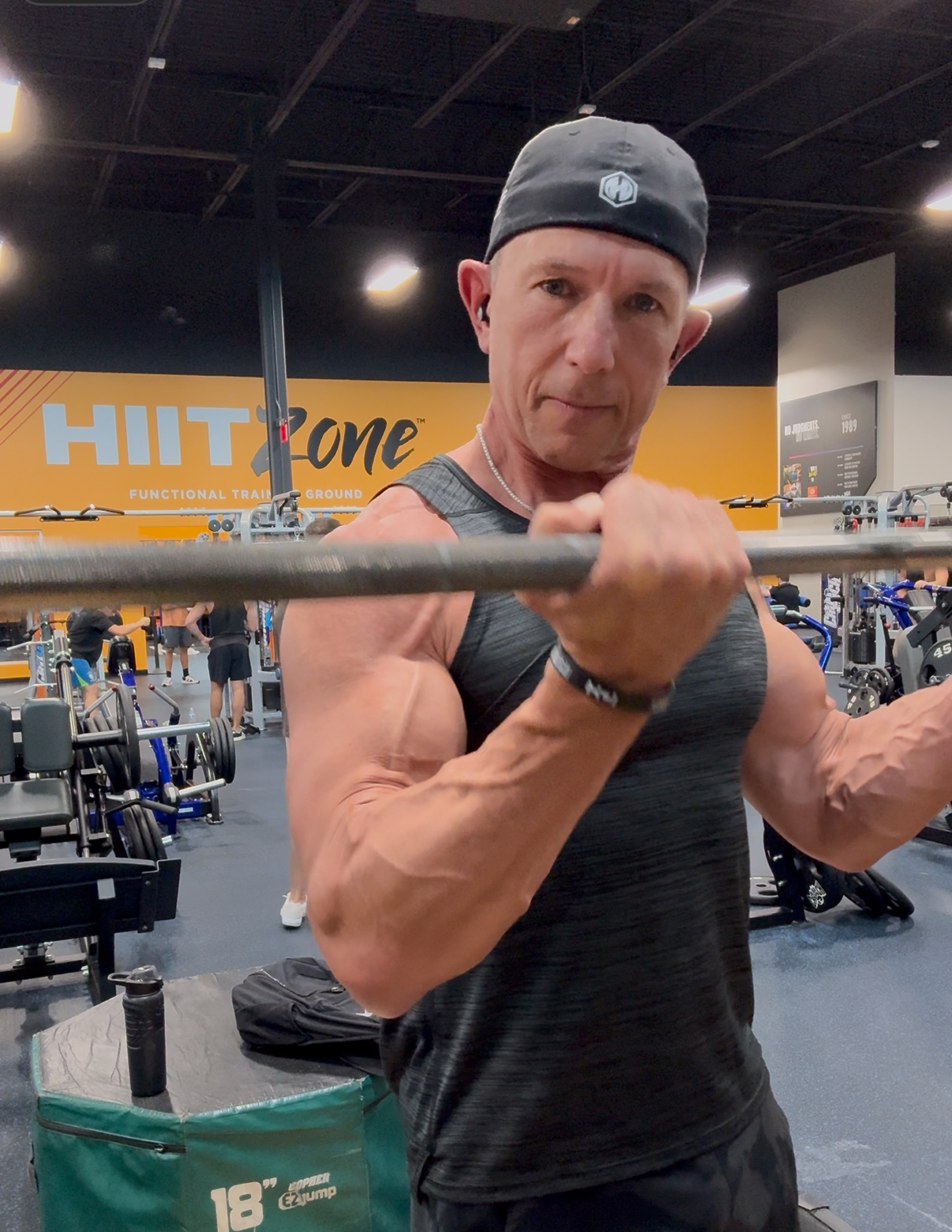
The Cholesterol Myth: Why LDL Isn’t the Enemy—and What Really Causes Heart Disease
By Dr. Andreas Boettcher, D.C., Functional Medicine, B.S. Health/Exercise Science
3x Ironman Triathlete, Master's Men's Physique Competitor
The Truth About Cholesterol: Why It’s Not the Villain You’ve Been Told It Is
Most doctors will tell you that the secret to living longer and preventing heart disease is simple — lower your LDL cholesterol. That’s why tens of millions of men are prescribed statins every year.
But here’s the problem: this message is outdated, overly simplistic, and in many ways, flat-out wrong.
Because cholesterol isn’t the villain.
It’s actually one of your body’s most important allies.
And when you understand the real science — not the decades-old fear campaign — you’ll see that what’s truly driving heart disease isn’t cholesterol at all. It’s inflammation, oxidation, insulin resistance, and metabolic dysfunction.
Let’s break it down.
Cholesterol: Your Body’s Repair Crew, Not the Arsonist
Think of cholesterol as the fireman rushing into a burning building. He’s not the cause of the fire — he’s there to fix the damage.
When your blood vessels get injured by inflammation, toxins, or oxidative stress, your body sends LDL (low-density lipoprotein) to the scene to help patch things up. Cholesterol helps rebuild damaged cells, protect the arterial lining, and restore normal function.
But here’s where things go wrong:
if your internal environment is inflamed, full of oxidative stress, and your LDL particles become damaged (oxidized), the repair job turns messy. The cholesterol meant to heal you gets “stuck,” and over time, plaque forms.
That’s not a cholesterol problem. That’s an inflammation and oxidation problem.
Cholesterol: Your Body’s Repair Crew — Not the Arsonist
Think of cholesterol as the fireman rushing into a burning building.
He’s not the cause of the fire — he’s there to fix the damage.
When your blood vessels become irritated or injured by inflammation, toxins, insulin resistance, or oxidative stress, your body sends LDL (low-density lipoprotein) to the scene to help patch things up. Cholesterol works like a natural repair molecule — helping to rebuild damaged cells, reinforce arterial walls, and restore normal function.
But here’s where things go wrong.
If your internal environment is filled with oxidative stress, inflammation, or high ferritin and insulin resistance, your LDL particles can become damaged (oxidized). When that happens, the repair job turns messy. The cholesterol meant to heal you becomes trapped in the arterial wall — creating the buildup we call plaque.
That’s not a cholesterol problem.
That’s an inflammation and oxidation problem.
The Truth About Cholesterol: What It Actually Does for You
Before we keep blaming cholesterol for every heart issue, it’s worth remembering one simple fact:
👉 Your body makes most of it — because it’s essential for life.
Roughly 75–80% of your cholesterol is made by your liver, and only 20–25% comes from your diet.
If cholesterol were truly the enemy, your body wouldn’t produce it every single day. It’s not a mistake — it’s a design feature of human biology.
Here’s why your body depends on it:
🧠 Supports Brain & Nervous System Function
About a quarter of your body’s cholesterol lives in your brain. It helps build and maintain myelin sheaths— the insulation around nerves that allows fast, clear communication between brain cells.
Cholesterol supports synapse formation, critical for learning, memory, and focus.
When cholesterol is too low, brain fog, anxiety, and cognitive decline often follow.
💪 Drives Hormone Production
Cholesterol is the starting molecule for all steroid hormones:
Testosterone
Estrogen
Progesterone
DHEA
Cortisol
When you lower cholesterol too much — for example, through statins or extreme low-fat diets — you block your body’s ability to produce these vital hormones.
That’s why so many men on statins experience fatigue, low libido, and a general loss of vitality.
I’ve yet to meet a man in my practice on a statin who also had optimal testosterone levels. Not one.
🧫 Maintains Cell Membrane Integrity
Every single cell in your body relies on cholesterol for membrane strength, flexibility, and repair.
It helps nutrients enter the cell and toxins exit safely.
Without it, cell walls become weak and prone to oxidative damage — accelerating aging from the inside out.
💥 Repairs Damage and Calms Inflammation
Cholesterol acts like your body’s built-in firefighter— sealing micro-tears in arterial walls caused by inflammation or stress.
It stabilizes damaged tissue, allowing the healing process to occur.
Elevated cholesterol can therefore be a response to inflammation, not the cause of it.
💧Aids Digestion and Nutrient Absorption
Your liver uses cholesterol to create bile acids, which break down fats and help absorb vital fat-soluble vitamins — A, D, E, and K.
Without enough cholesterol, your digestion and nutrient absorption suffer.
☀️ Enables Vitamin D Production
Sunlight interacts with cholesterol in your skin to produce vitamin D3, the hormone that regulates mood, immunity, and bone health.
Without cholesterol, that process simply doesn’t happen.
🛡️ Supports Immune and Antioxidant Defense
Cholesterol helps transport antioxidants like vitamin E and CoQ10 through your bloodstream.
It stabilizes immune cell membranes and assists your body in responding to infections and inflammation.
🔑 Bottom Line
Cholesterol isn’t your enemy — it’s your body’s repair and protection system.
Your liver doesn’t make mistakes; it makes cholesterol on purpose to keep you alive, resilient, and hormonally balanced.
So instead of asking,“How do I lower it?”
The smarter question is:
“Why is my body making more?”
When you fix the inflammation, oxidation, and metabolic imbalance, your cholesterol naturally finds its healthy range.
A Brief History of Cholesterol: How “Healthy” Became Redefined
If you look back just a few decades, you’ll notice something fascinating — and deeply concerning.
In the 1950s and 60s, the “healthy” total cholesterol range for men was between 220–260 mg/dL. That wasn’t considered dangerous; it was normal. These were the same decades when our grandparents ate eggs, butter, and steak daily — long before the explosion of ultra-processed seed oils, refined carbohydrates, and sedentary desk jobs.
But as pharmaceutical influence grew, those “normal” numbers began to drop.
By the 1980s, “borderline high” cholesterol was anything over 240 mg/dL.
By the 1990s, the target was lowered again — now “ideal” was considered below 200 mg/dL.
Today, many doctors want you below 180 mg/dL, or even lower if you’re on a statin.
What changed?
Not the human body.
The definition.
And with every new threshold, millions more men suddenly became “at risk” — creating a market for more prescriptions. Yet during this same time, cardiovascular disease has remained the number one killer with numbers STILL SKYROCKETING among men and women worldwide.
So, we have to ask the obvious question:
If lowering cholesterol was truly the answer, why are heart disease rates still climbing?
At what point do we start questioning a narrative that keeps redefining health in ways that create more patients… not fewer?
Because when you step back, it’s clear — we don’t have a cholesterol problem. We have an inflammation, oxidation, and lifestyle problem.
Let's dive deeper?
If cholesterol isn’t the bad guy, what is?
The real culprits are the root-cause disruptors that damage your blood vessels and set off an inflammatory cascade:
Insulin resistance — when your cells stop responding to insulin, blood sugar and triglycerides rise, LDL particles become smaller and denser, and your arteries take the hit.
Visceral fat — the deep belly fat around your organs that pumps out inflammatory cytokines like IL-6 and TNF-α, damaging your blood vessels from within.
Oxidative stress — excessive free radicals oxidize LDL particles, turning them sticky and atherogenic.
Homocysteine — when elevated, it directly damages the delicate endothelial lining of your arteries, causing microscopic “cracks” that invite cholesterol in to repair them.
High ferritin and iron overload — iron acts like gasoline on the oxidative fire, accelerating LDL oxidation and arterial injury.
Chronic low-grade inflammation — reflected in markers like hs-CRP and IL-6, which predict cardiovascular risk better than LDL ever could.
In short:
the problem isn’t cholesterol. It’s the environment cholesterol lives in.
If you have inflammation, insulin resistance, oxidative stress, and endothelial damage, cholesterol becomes part of the problem.
If you don’t, it’s part of the solution.
Statins: The Most Overprescribed Drug in History?
Let’s talk about the elephant in the room — statins.
They’ve been on the market for over 30 years and are prescribed like candy. Yes, statins lower LDL, and yes, may lower the risk of heart attacks in a small minority of high-risk patients (debatable). But for most healthy adults, especially men using them for prevention, the benefits are shockingly small.
In fact, one major meta-analysis found that 100 men would need to take a statin for five years for just one to avoid a non-fatal heart attack. That’s a 1% benefit. And there’s no evidence they extend lifespan for most people without existing heart disease.
Here's the kicker, despite their ubiquitous use Cardiovascular Disease remains the number killer among men in the United States with numbers still skyrocketing as I mentioned earlier.
What they do reliably cause are side effects:
Muscle aches and pain
Depleted CoQ10 (critical for cellular energy and mitochondrial health)
Brain fog, fatigue, and hormone disruption
Lower testosterone production (since they block the same enzyme needed to make both cholesterol and testosterone)
NOTE: In my 33+ year career I have YET TO SEE ANY MAN ON A STATIN WITH HEALTHY LEVELS OF TESTOSTERONE!
In fact, there is no world in which I personally would ever take a statin.
Statins treat a number, not the problem.
And the number they treat — LDL — is only one small piece of a much bigger picture.
Let's present the argument this way.
Take a look at the two photographs below.
IMAGE ONE: Your "Average" adult male in America today with excess body fat, insulin resistant (if not diabetic), inflamed, tanking testosterone, ED, etc....
BUT HE IS ON A STATIN, even TRT and if we are honest, likely BP meds, thyroid medication, and the list goes on....(none of which treat the above)

OR
IMAGE TWO: Someone like myself—same age at 55—has optimized labs across the board: restored healthy testosterone levels naturally (even when they tanked at the age of 47, balanced cholesterol (even higher than what traditional medicine typically recommends), triglycerides in the 30s, HDL in the 90s, no issues with Lp(a), and zero signs of insulin resistance or chronic low-grade inflammation.
NO STATINS, NO TRT, NO MEDICATIONS OF ANY KIND!

Here's the Million dollar question....Who do you think has the lower risk of heart disease?
Who are you placing your bet on?
Someone who falsely believes their medication will save the day (regardless of lifestyle) or the man who is actually doing the work that makes him healthy, fit and strong?
I'll take my odds all day long!
Why Low Cholesterol Can Be Dangerous
When you drop cholesterol too low, especially below 150 mg/dL total, you increase your risk of depression, memory issues, and hormonal imbalances.
Your body literally can’t function optimally without it.
So instead of obsessing over lowering cholesterol, we should be asking:
Is my cholesterol oxidized or inflamed?
Is my body insulin-resistant or metabolically broken?
The Real BioMarkers of Heart Risk Below The Surface of Excess Body/Visceral Fat
Here’s what actually tells you your cardiovascular risk:
Triglycerides/HDL ratio — one of the best predictors of insulin resistance and heart disease.
A ratio under 1.5 is ideal.
hs-CRP (C-reactive protein) — tells you if inflammation is present.
Homocysteine — elevated levels damage the arterial lining.
Ferritin and iron saturation — excess iron increases oxidative stress.
IL-6 — a cytokine that reflects chronic inflammation.
Insulin and fasting glucose — show metabolic health.
LDL particle size — small, dense particles are far more dangerous than large, buoyant ones.
If you want to know your true cardiovascular risk, you must test beyond the standard lipid panel.
Otherwise, you’re guessing.
Functional Medicine’s View: Fix the Terrain
In functional medicine, we don’t treat lab numbers — we treat the terrain.
If your internal environment is toxic, inflamed, and metabolically broken, lowering LDL won’t save you.
If your internal environment is healthy, even a higher LDL may be protective.
That means focusing on:
Reducing visceral fat through strength training and low-glycemic eating
Improving insulin sensitivity by cutting refined carbs, seed oils, and processed foods
Lowering inflammation by managing stress, improving sleep, and increasing omega-3s
Supporting detox pathways and reducing oxidative stress
Keeping hormones optimal, especially testosterone
Ensuring proper nutrient status — magnesium, vitamin D, B vitamins (for homocysteine), and antioxidants
When you do this, your lipids normalize naturally — and your risk of heart disease plummets.
The Takeaway
Cholesterol isn’t your enemy. It’s your ally.
The real danger is what causes cholesterol to oxidize and stick — insulin resistance, inflammation, poor diet, and oxidative stress.
Instead of fighting cholesterol, start fixing the environment it operates in.
That’s how you protect your heart, your brain, and your hormones — all at once.
You don’t need another pill.
You need a plan.
One built on lifestyle, lab precision, and a deeper understanding of how your body really works.
⚡️ Ready To Take Charge of Your Health With the Most Comprehensive Natural Approach to Mens Health?
If you’d like to go deeper — to uncover the root causes behind your energy, hormones, metabolism, and performance — I invite you to book a complimentary consultation.
Together, we’ll review your health history and goals and determine if our Peak Performance Protocol based on your lab analysis, genetics, and lifestyle data is right for you!
👉Click here to schedule your complimentary consultation.
To learn more about our approach and success stories, visit www.ItsOnlyHalftime.com where we help men like you turn your second half into your best half naturally!
Finish Strong,
Dr. Andreas
Still Kickin' A** Medication Free at 55 Despite What the "Narrative" Would Like You To Believe!

Medical Disclaimer:
The information provided in this article is for educational and informational purposes only and is not intended as medical advice. It should not replace professional consultation, diagnosis, or treatment. Always consult your healthcare provider before making any changes to your health regimen or lifestyle.
References
JAMA. Association Between Baseline LDL-C Level and Total and Cardiovascular Mortality in Randomized Trials.
PMC8315613. Cardiovascular Mortality After Intensive LDL-Cholesterol Lowering: Meta-Analysis of 53 RCTs.
PMC9726298. Association of LDL-C Levels With Risk: Systematic Review and Meta-Analysis (1,232,694 participants).
PMC10982736. Is LDL Cholesterol Associated With Long-Term Mortality Among Adults 50–89 Years?
Low-Density Lipoprotein Cholesterol and Mortality Outcomes in Older Adults. Journal of Gerontology.
Do Statins Decrease Testosterone in Men and Women? BMC Medicine, 2013.
LDL Cholesterol Treatment Strategies and Meta-Analyses. ScienceDirect, 2016.
Extent of LDL-C Reduction and Mortality: Meta-Analysis of 60 RCTs. PubMed 39126771.
Association of Statin Use and Sex Hormone Levels in Men. Journal of Clinical Endocrinology & Metabolism.
Course of Effects of LDL-C Reduction on Cardiovascular Risk Over Time. PubMed 39126771.


